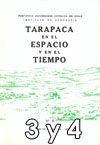Guatacondo: A case of agricultural and cultural transformation in the arid zone
Keywords:
TRABAJO DE CAMPO, Geografía cultural, conservación de población, migración de poblaciónAbstract
The present work is based on the field experience, carried out in 1971-1972, in the Guatacondo area (I Region). In its first part, the Guatacondo ravine is placed in its geological, geographical and historical-cultural context. In the second part, the characteristics of agriculture in the area are examined (type of fields, irrigation methods, work elements, markets, production, etc.). The growing decrease of the cultivated area and the consequent migration of the population to other population centers are noted. Faced with the abandonment of the area, the author discusses two alternatives: a) eradication of the population and their resettlement in more suitable places; b) conservation of the population in the area, through diversification of their agriculture and adoption of new cultivation techniques and rational use of water, as well as cooperative forms of work. The following two alternatives: a) eradication of the population and their resettlement in more suitable locations; b) conservation of the population in the area, through diversification of their agriculture and adoption of new cultivation techniques and rational use of water, as well as forms of cooperative work.






